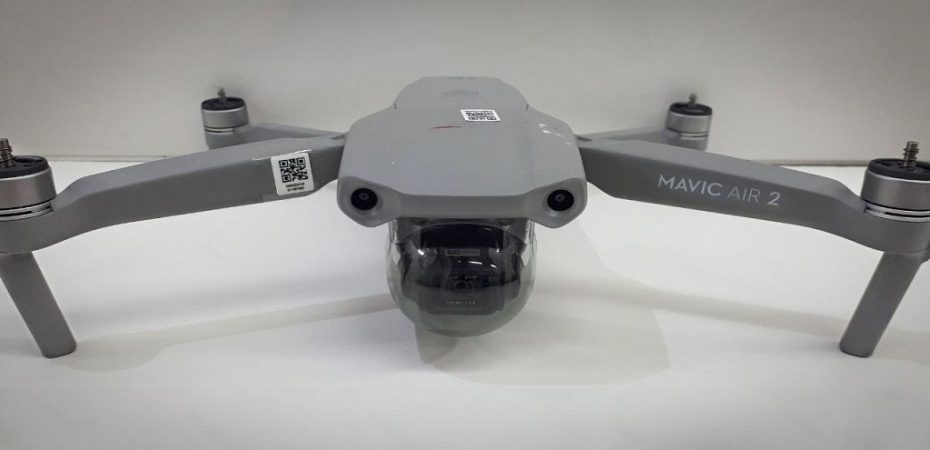OUR VERDICT
DJI Mavic Air 2 is excellent for you to capture stunning aerial photos and 4K videos, but you also want to stay under $1000. We give Mavic Air 2 top marks for photo and video quality, range of features, battery life, and price.
Mavic Air 2 Pros And Cons
Pros
- Impressive battery life
- Accurate controls
- Stunning photos and video
- Excellent value for money
Con
- Unattractive design and color
When the predecessor of the Mavic Air 2, the DJI Mavic Air, was introduced, it made quite a mark in the market due to its impressive features and design. It was easy to maneuver, recorded excellent quality 4K videos, and folded for storage and traveling.
It seems DJI has managed to do it again with the Mavic Air 2, which is even better than Air 1; the video recording has been taken up a notch with 4K quality at up to 60fps. Amazing 48MP stills and 240fps slow-motion video recording, plus a few additional features.
The motion tracking has also been refined on the Mavic Air 2, which allows it to stay locked on a moving object even if it disappears from the camera’s field of view momentarily.
The flight time has also been upgraded to 34-minutes. While the Mavic Air 1 was initially priced at under $1000, the Mavic Air 2 wowed us all with its $799 price tag (for the standard configuration)
Key Features
- Total weight 570g (1.25 lbs.)
- Size (L×W×H) Folded 180×97×74 mm; Unfolded 183×253×77 mm
- Image Sensor 1/2″ 48MP CMOS
- Equivalent Focal Length 24mm; FOV 84º, Aperture f/2.8; Focus Range 1 m to ∞
- 12MP and 48MP photos
- 4K/60p and HD/240p video at 120Mbps
- 10km 1080p Video Transmission
- H.264 and H.265 codecs
- HDR video and panorama
- 8K HyperLapse
- 68 kph (42 mph) max speed
- Stabilization 3-axis (tilt, roll, pan)
- Downward Sensors include Dual Vision Sensors and Time of Flight Sensors (ToF)
- Spotlight 2.0 subject tracking
- Advanced Pilot Assistance System (APAS) 3.0
- Internal Storage 8 GB
- 34-minute max flight time; Battery Capacity 3500 mAh
Price and Availability
The Mavic Air 2 comes in two configurations – the standard kit costing $799 includes the drone, a battery, and the remote control. The second combo, “Fly More,” which costs $988, has all the standard package items, plus ND filters, a shoulder bag, three batteries, and a charging hub.
Design

At first glance, the Mavic Air 2 seems to have some similarities to the design of the Mavic Mini. DJI used almost the identical shade of gray, the folding structure. However, these two drones are very different; Mavic Air 2 is heavier and feels more durable; it is also larger in size, while the Mavic Mini is smaller and toylike in quality.
In our opinion, The Mavic Air 2 has far more similarities to the Mavic 2 Pro than its predecessor. Although the design of the Air 2 is a step towards a unified look for the Mavic line, we think the original Mavic Air had a more stylish look with this silver, black and white color combo and a smooth top. The all-gray look of the Air 2 looks somewhat jaded and unexciting. Don’t get us any wrong, it is still a good-looking drone, but we find ourselves reminiscing about the exciting sleekness of Mavic Air. Plus, it doesn’t help that the dull gray color is difficult to see on overcast days, affecting maneuverability.
The location of the sensors on the Mavic Air 2 is the same as the original Air; they are placed in front, bottom, and rear, which ensure that the drone avoids any obstacles and objects in its path. The Air 2 also has DJI’s upgraded version of the obstacle-avoidance system and the latest APAS or the Advanced Pilot Assistance System 3.0, allowing the drone to decide a path around other objects. Unfortunately, the APAS is limited to 4K/30 fps video shooting and turns off automatically at higher video frame rates.
A unique feature of the Mavic Air 2 is the Air Sense – it is able to receive ADS-B signals from piloted airplanes, which enables it to show the aircraft’s location on the remote controller’s screen. Initially, drones with this feature were only available in North America, but now it is sold all over the world.
Controller

The DJI Mavic Air 2 has a reimagined and completely redesigned controller, which is very different from the one that came with the original Mavic Air. The newest version is larger, almost twice in size from all the other controllers of the Mavic line. The down-folding arms that are meant to hold your phone have been replaced by a spring-loaded bracket, which is more versatile for different sizes of smartphones and provides a better grip.
Connecting your smartphone, especially an iPhone, has also been simplified, which is a much-appreciated move since previously, the process was far too fussy.
The control sticks for maneuvering have been kept the same as other DJI controller models. Although a few additional buttons have been added to the setup, the remote feels bulkier and more substantial. The control sticks can be unscrewed for easier storage.
Although you’ll have to test out the controller to see if the larger size works for you, we found it more intuitive to have the phone display on top of the control sticks. Everything felt like it was just in the right place. The enhanced transmission range of 10k is excellent! Now you can be up to six miles away without worrying about getting clear feedback on your phone. However, it’s always better to keep the drone in sight.
Camera Features
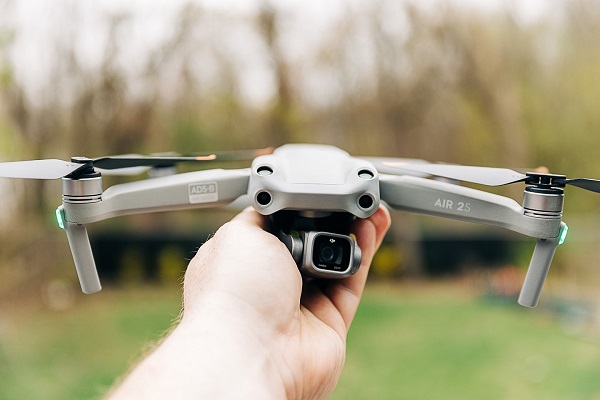
The Mavic Air 2 will come with the exact 12MP resolution as its predecessor. Still, the larger image sensor of ½-inch gives it the edge over Mavic Air’s smaller 1/2.3-inch sensor, allowing it to capture videos at a higher frame rate.
DJI Mavic Air 2 is also equipped with a Quad Bayer sensor and pixel binning technology, which allow it to capture 48MP high-resolution photos. The photos from Air 2 are pretty impressive; the results are clear and crisp. However, you have to make sure not to take pictures from too far away because that reduces detail and sharpness.
Moving on to another seemingly unique feature of the Air 2 is Hyperlight, which is DJI’s take on night mode photos. The Air 2 camera captures multiple low-light photos, which it merges to create a brighter image.
In terms of HDR photography, the Air 2 has the ability to capture HDR photos by shooting and merging seven simultaneous photos for the best results. On the other hand, Mavic Air only took three photos.
Finally, we have to talk about the SmartPhoto feature that we enjoyed a lot because it gave us some pretty good results. The Mavic Air 2 camera is able to detect five different types of scenes – blue skies, sunsets, grass, trees and snow, – which prompts the system to select the right camera preset for the best quality photo.
Video features
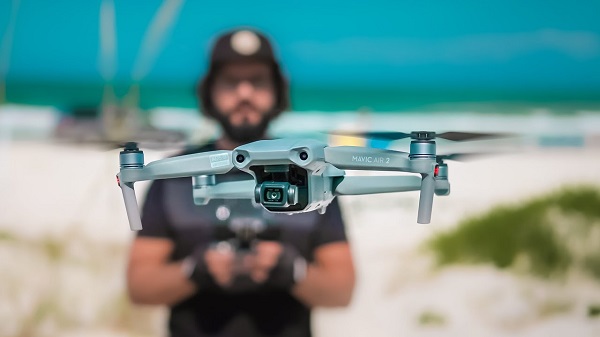
The Mavic Air 2 beats Air with a huge margin as it can record videos up to 4K at 60fps, whereas Mavic Air can record videos up to 4K at 30fps. You can record 1080p videos at 240fps. The Mavic Air 2 allows you to record 4X and 8X slow-motion videos and HDR videos with 4K/30fps max video resolution.
In some ways, the Mavic Air 2 performs comparatively better than the Mavic 2 Zoom. DJI Mavic 2 Zoom has a smaller 1/2.3 image sensor than Mavic Air 2 that can shoot videos at a maximum resolution of 4K/30fps. Mavic Air 2 also has a 2x zoom lens that significantly improves the video quality and allows you to perform some neat video tricks.
Talking about stability, Mavic Air 2 offers impressive stability even in moderate to high wind conditions. The videos are usually stable and smooth, similar to videos recorded with a camera mounted on a tripod. The correctness of colors on video is also spot on! The camera does not over-saturate or sharpen the objects. Due to the accuracy of the camera, you do not have to readjust the colors, brightness, exposure, contrast, or other settings.
The camera performs better on sunny days; the accuracy of the objects and landscape is up to 85%. To add to the camera’s video performance, DJI has introduced several new and advanced features for making videos more cinematic and accurate.
With DJI’s ActiveTrack 3.0 feature, you can select a subject, and the drone will automatically follow the selected object. This feature is popularly known as “FOLLOW ME,” Follow me drones are pretty popular amongst sport and adventure lovers. The follow-me mode of the Mavic Air 2 is highly accurate, and the drone follows the subject without failing, so you can enjoy your adventures and rely on Mavic Air 2 to capture its realistic video.
We tried the Active 3.0 feature, and the drone successfully avoided objects and re-lock on our selected object. Although the camera recognizes and follows the object chosen if it is hidden, if the object remains hidden for more than a few seconds, the drone loses its object lock. Therefore, ensure that your selected object does not remain hidden for more than a few seconds for a stable connection.
Spotlight 2.0 feature looks onto a subject and ensures that the subject is always in the frame as you pilot the drone. This DJI Inspire drone feature is excellent for moving objects and capturing various angles of a stationary object. You can also take high-resolution time-lapse videos with Mavic Air 2.
Battery Life
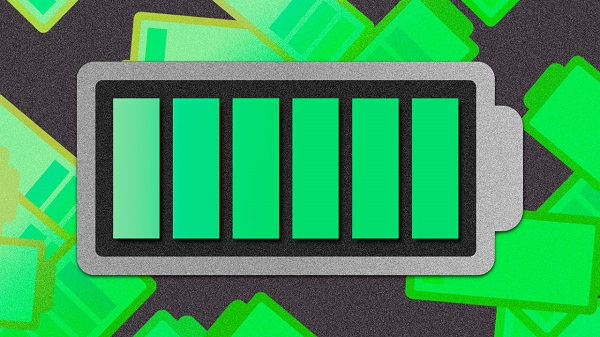
According to DJI, the Mavic Air 2 can fly for up to 34mins under favorable conditions, making the Mavic Air 2’s battery life 14mins longer than the Mavic Air and a couple of minutes longer than the all-time popular Mavic Mini.
However, when we tested the Mavic Air 2, the battery time of the first flight was 23 minutes and 14 seconds. If you talk about hovering (usually a battery draining feature), Movic Air 2 lasts about 22-25 minutes while hovering for photos and videos, which is impressive.
The battery charging time is also reasonable; it usually takes 1 hour and 45 minutes to charge the DJI Mavic Air battery completely. You can also replace the batteries; extra batteries for Mavic Air 2 cost about $115 each.
Overall Performance
The DJI Mavic Air 2’s overall performance is terrific. It offers a number of notable characteristics in addition to the image quality details mentioned above.
With a flight time of over 34 minutes, the drone allows you to fly numerous times on a single charge. You nearly will never worry about running out of battery power with the fly-more kit!
The tracking functionality is another significant performance boost.
Using clever tracking modes, it’s simpler than ever to produce fascinating videos as a lone maker. The drone can fly independently and quickly avoid obstacles, even in challenging environments.
The DJI Mavic Air 2’s quiet operation sound is another pleasant performance improvement. The improved design reduces propeller noise by about 10-20dB, depending on the conditions.
When flying near other people helps you to be less distracted.
Additional Useful Features
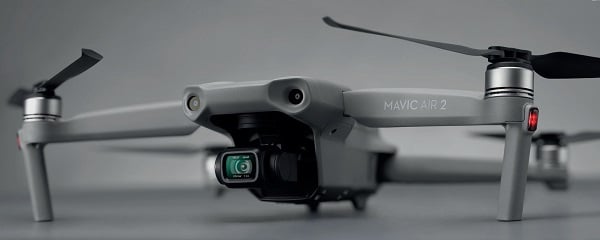
A few minor improvements that made the DJI Mavic Air 2 stand out for me included the simplified one-piece gimbal cover and the ability to mount your phone in the controller without removing the case.
There’s also a built-in alert system for human-crewed aircraft. I’ve never received any warnings through this feature (probably because I typically fly in remote areas of the mountains). Still, it’s nice to know that DJI is interested in improving its interface to avoid interactions with aircraft.
The other improvement DJI made was in obstacle avoidance. It appears more responsive and effective at avoiding crashes by sensing obstacles in front, back, and downward directions.
With respect to operating a drone, there are some extras that must be considered.
First and foremost, extra batteries are pretty helpful (even though the 34-minute flight time will be enough for multiple flights). Probably the most frustrating feeling is having a fantastic photo opportunity and then getting a battery-low alert just as you’re about to snap something spectacular.
Extra props are highly recommended if this is your first drone. Since DJI drones are always so resilient, they will most likely continue to fly after a crash, although broken props (which are incredibly affordable) will have to be replaced. Don’t be concerned about crashing if you keep a few extras on hand.
Finally, owning a landing pad for takeoff on rainy, dirty, or uneven terrain is exceptionally beneficial. Hand launch/landing is also feasible but requires a little more expertise (and you risk severe cuts on your hands from sharp propellers).
After you have all these attachments, a case to store them in is handy. It will keep you structured and prevent you from searching for filters when you should be photographing the sunset.
Value for Money
The DJI Mavic Air 2 is a fantastic value for the performance it provides. It has an extremely long flight time, amazing photo/video specifications, and a remarkably small size.
Regarding features, this drone competes with much more expensive drones for roughly US$800. With so many options within the drone market, it might be challenging to choose. However, the DJI Mavic Air 2 is a wonderful pick.
The capacity to record 48-megapixel still photographs is the most valuable feature of this drone for me. Because of the high quality of the pictures, this drone is significantly more enticing compared to some of the lesser-resolution options.
If you’re looking for a drone, the Mavic Air 2 is among the most robust options on the market in terms of value/specs/size.
Verdict
Without a doubt, Mavic Air 2 is an impressive skye drone. With tons of features for improving the drone flying experience, excellent aerial photo and video quality, good battery life, and a sturdy build, DJI has justified the price of Mavic Air 2.
Although it is twice as costly as the Mavic Mini, $500 less than the Mavic 2 Zoom, and almost half the price of the DJI Mavic 2 Pro, it still strikes the perfect balance of cost vs. features.
So, if you don’t want to spend more than $1000 but still want a drone that captures stunning aerial photos and videos, is compact yet sturdy and comes with features that are available in some high-end drones, then we highly recommend Mavic Air 2.
We hope that you will find our skye drone review helpful! Have you tried Mavic Air 2? Please share your drone experience with us in the comments section below.
Read Also

